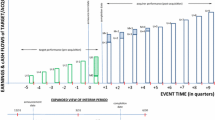Abstract
Goyal and Wahal showed that plan sponsors typically lose value when firing an underperforming manager and hiring its replacement. Experience suggests that most investors appreciate this research but then ignore it when making decisions. To redress this problem, we build a model that shows an investor its expected loss from hiring and firing its managers for performance reasons. By knowing this likely loss, we hope that investors will make fewer performance-related decisions and therefore improve their returns. Another useful part of the model is that it can also project an investor's likely gain from ‘taking profits’ from a manager with exceptional outperformance.





Similar content being viewed by others
Notes
Many investors find it hard to acknowledge that their manager replacement decisions are performance related. After all, the interaction between a manager's past performance and its appeal to an investor is sometimes subtle. For example, one would expect managers to make better presentations to investors after good performance (as they have more confidence and can use better examples). Moreover, all managers have some weaknesses in their process; they just tend to come under more focus when the manager has recently underperformed. Given these difficulties, we encourage all investors to analyse the past performance of their recent manager appointments and terminations. For each appointment in the last 3 years, for example, investors could rank the performance of the shortlisted managers in the 3 years before the hiring decision, noting the position of the manager that was actually hired. If the investor typically chose the ‘best performer of the three’, then the investor's preference for past performance is unlikely to be accidental. In a similar vein, investors could study the managers that they recently terminated. They could calculate the average information ratio of these managers in the 3 years before their termination. A negative average would again suggest that the investor's preference for past performance is more than accidental.
To aid simple exposition, we assume that these possible replacements have the same return distribution as the incumbent manager. However, this need not be the case.
Taking this assumption alongside the one directly before it implies a net information ratio of 0.2. We consider this appropriate for the base case, given our experience of client portfolios that contain our highly rated managers. Given Penfold (2004), we form our tracking error estimate through a qualitative risk assessment of the manager's portfolio, rather than relying exclusively on the results of risk models.
The model works on any distribution of excess returns. We have tested the Variance-Gamma distribution, as it provides more realism through its fat tails. In our base case, however, we opted for the lognormal distribution, given its broad appeal and the ease with which its parameters can be interpreted.
We assume a slight level of mean-reversion in our base case. We do so because our experience – and that of Goyal and Wahal – shows that investors tend to lose value when they replace managers for performance reasons. Of course, if the excess returns of most managers typically trended – rather than mean-reverted – then these performance-following investors would tend to gain value. (After all, they would buy future winners and sell future losers.) As no gain in value is generally observed, we conclude that the excess returns of most managers exhibit some level of mean-reversion. Support for this view is also generally available from empirical studies that remove the effects of survivor bias. In one such study by Busse et al (2010), the authors find that better manager excess returns from the previous year tend to lead to worse excess returns in the following 3 years.
Furthermore, polynomial forms barely improved upon the explanatory power of the linear regression. In addition, the P-values of all the regression coefficients in this article are significant at the 0.1 per cent level, with the exception of the case with no autocorrelation in Figure 5. The P-value of this regression's slope coefficient is significant at the 20 per cent level.
As we noted, the ‘best-fit’ line only explains a small amount of the overall variation in this chart. However, it can lead to a change in expected value that is comparable to a manager's expected excess return, and so is certainly worth considering.
We accept that the explanatory power of the model's regression is low for any particular manager. Using the model across many of the investor's managers, however, improves the chance that the investor gains good performance by following the model's results.
References
Busse, J., Goyal, A. and Wahal, S. (2010) Performance and persistence in institutional investment management. The Journal of Finance 65 (2): 765–790.
Goyal, A. and Wahal, S. (2008) The selection and termination of investment management firms by plan sponsors. The Journal of Finance 63 (4): 1805–1847.
Penfold, R. (2004) How Well Do Three Risk Models Forecast Risk? Russell Research Commentary, Russell Investment Group.
Acknowledgements
I would like to thank George Aristides, Robert Brown, Stephen Miles and Charlie Ullman for their help with this article. All errors are my own.
Author information
Authors and Affiliations
Corresponding author
Additional information
Disclaimer This document was prepared for general information purposes only and should not be considered a substitute for specific professional advice. In particular, its contents are not intended by Towers Watson to be construed as the provision of investment, legal, accounting, tax or other professional advice or recommendations of any kind, or to form the basis of any decision to do or to refrain from doing anything. As such, this document should not be relied upon for investment or other financial decisions and no such decisions should be taken on the basis of its contents without seeking specific advice.
This document is based on information available to Towers Watson at the date of issue, and takes no account of subsequent developments after that date. In addition, past performance is not necessarily indicative of future results. In producing this document Towers Watson has relied upon the accuracy and completeness of certain data and information obtained from third parties.
This document may not be reproduced or distributed to any other party, whether in whole or in part, without Towers Watson's prior written permission, except as may be required by law. In the absence of its express written permission to the contrary, Towers Watson and its affiliates and their respective directors, officers and employees accept no responsibility and will not be liable for any consequences howsoever arising from any use of or reliance on the contents of this document including any opinions expressed herein.
Copyright © 2012 Towers Watson. All rights reserved.
Rights and permissions
About this article
Cite this article
Penfold, R. How much value should you expect to gain or lose by replacing your investment manager?. J Asset Manag 13, 243–252 (2012). https://doi.org/10.1057/jam.2012.10
Received:
Revised:
Published:
Issue Date:
DOI: https://doi.org/10.1057/jam.2012.10




